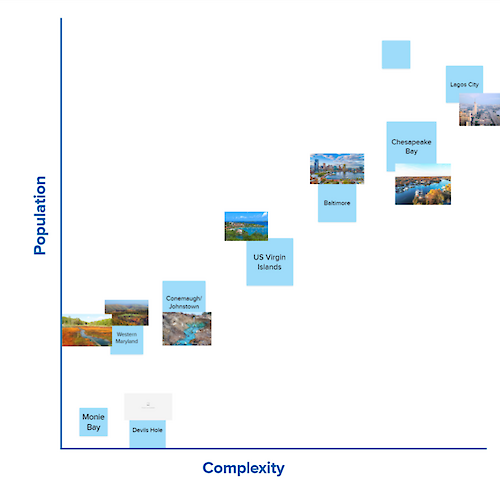Scaling Environmental Management Extends Beyond Population Size
Kayla Fairfield ·Environmental management is highly complex and site-specific. There is no “one size fits all” solution. Management practices must adapt to different challenges for each scenario on a case-by-case basis. Factors that impact environmental regional management practices are population size, geographic size, the maturity of governmental systems, and the length of time that an environmental issue has impacted that region. The weight of these impacts and the complexity of the issue determine the scale of the response necessary to address the problem. Cases with large scope, or high complexity, often require large-scale responses and more formal interactions. Small-scale case studies allow for more direct communication and greater flexibility in management 8.
Some aspects of environmental management are independent of size, maturity, or span of environmental impact. These can include effective communication, regional differences, contentious issues, consensus among stakeholders, and the incorporation of monitoring programs and research. These issues may be present for an environmental issue regardless of its scope or complexity.

A conservation strategy used throughout the world is decentralized environmental management. This is where the government cedes decision-making to smaller non-governmental groups. Community-led environmental management can have meaningful outcomes due to a high level of trust, greater equity, quicker responsiveness to problems, and effective resource mobilization 1,3. These community organizations make management decisions through communal governance. There are intrinsic challenges with this style of management. Decentralized groups often have fewer resources to work with which can limit their ability to scale their response appropriately, and tensions can arise with their governmental organizations 5.
The maturity of community-based environmental management impacts the success of conservation management and the scale of communal governance-led efforts. A 2019 study evaluated this relationship within environmental management groups in Kenya 4. The study focused on organization structures dependent on maturity which affects the success of management. These structures include internal processes, decision-making, external collaboration, dealing with internal conflict, and self-reflection of their objectives 4. These factors affect social trust and collaboration, which influence a group’s ability to reach its goals. In more mature community groups, these structures are more robust compared with less mature groups.

The Samburu tribes, a group of semi-nomadic pastoralists, in the Namunyak Wildlife Conservancy. Namunyak Wildlife Conservancy, Samburu, Kenya by Ninara from Flickr- CC by 2.0
Pretty and Ward (2001) describe the evolution of a group’s performance: reactive-dependence, realization-independence, and awareness-independence 6. With reactive-dependence, a group has simple goals in response to a threat and may rely on the support of outside organizations. Realization-independence is characterized by a group’s development of internal structures of the organization and increased group investment. Awareness-independence is the most mature stage, where internal structure is well established, goals are adaptive, and there is greater confidence in their capability to achieve their goals 4,6. Although the maturity of an organization or government does not necessarily decrease the complexity of the problem, greater maturity can increase the likelihood of success by allowing the organization to scale its efforts more efficiently.
Another factor that can increase the complexity and decrease the efficacy of environmental management efforts is how established an environmental concern is. Inaction can be caused by a variety of mechanisms such as lack of understanding or awareness, denial of science, politicization, higher requirements for the burden of proof, or slow management response 2. In the case of climate change, the time that has occurred between each stage of the issue has extended through multiple generations of humans 7. During the Industrial Revolution, human activity first began contributing to climate change. It wasn’t until decades later that the effects of carbon emissions started to be seen and understood. There has been a substantial delay in policy to address this known issue. The positive impacts of policies that have been changed will take years to be fully realized. The complexity of climate change is tied to the scale of the environmental problem and the impact of decades of insufficient action.

The scope of population or geographic size, maturity of a governance group, and duration of an environmental issue can add additional complexity to environmental management and conservation efforts. As the complexity of an environmental issue increases, governments and organizations must scale their response. Stakeholder engagement, monitoring programs, science communication, outreach, and community building must be scaled up to overcome the challenges of added complexity. Understanding how factors of complexity impact an environmental issue will allow governance bodies to better scale their management practices.
References
- Ahmad, M. S., & Abu Talib, N. B. (2015). Empowering local communities: decentralization, empowerment and community driven development. Quality and Quantity, 49(2), 827–838. https://doi.org/10.1007/s11135-014-0025-8
- Karlsson, M., & Gilek, M. (2020). Mind the gap: Coping with delay in environmental governance. Ambio, 49(5), 1067–1075. https://doi.org/10.1007/s13280-019-01265-z
- Kiwango, W. A., Komakech, H. C., Tarimo, T. M. C., & Martz, L. (2015). Opinion Article Decentralized Environmental Governance: A reflection on its role in shaping Wildlife Management Areas in Tanzania. Tropical Conservation Science, 8(4), 1080–1097. www.tropicalconservationscience.org
- Maynard, L., & Jacobson, S. K. (2019). The influence of group maturity on community-based environmental management in Kenya. Journal of Environmental Planning and Management, 62(14), 2567–2587. https://doi.org/10.1080/09640568.2019.1572346
- Oosterveer, P., & Van Vliet, B. (2010). Environmental systems and local actors: Decentralizing environmental policy in Uganda. In Environmental Management (Vol. 45, Issue 2, pp. 284–295). https://doi.org/10.1080/09640568.2019.1572346
- Pretty, J., & Ward, H. (2001). Social Capital and the Environment. World Development, 29(2), 209–227. www.elsevier.com/locate/worlddev
- Underdal, A. (2010). Complexity and challenges of long-term environmental governance. Global Environmental Change, 20(3), 386–393. https://doi.org/10.1016/j.gloenvcha.2010.02.005
- William Dennison. (2024, March 27). Scaling Environmental Management: Population, Area and Complexity Case Studies.
About the author
Kayla Fairfield

About the Author: Kayla Fairfield is a first-year PhD student in Marine Estuarine & Environmental Science at the University of Maryland Center for Environmental Science. She graduated in 2018 with her M.Sc. in Aquaculture from the Scottish Association for Marine Science. Kayla is passionate about aquaculture, restoration work, environmental education, and the Chesapeake Bay. Her interests have combined to inspire her project to develop better methods for blue crab aquaculture. Kayla is a graduate research assistant in Dr. Eric Schott and Dr. Louis Plough's labs.
Next Post > CERF Conference in Portland Oregon
Comments
-
Joy Amadi 1 month ago
Yes, you are right when you say that ignorance can be a major hindrance to acting or taking immediate actions on critical issues. Because of this, raising public awareness of a persistent problem is crucial in order to facilitate collaboration in the development of workable solutions. Nice blog!
-
COLIN SCOTT VISSERING 1 month ago
Kayla - nicely written blog and synthesis of the issue of scale in environmental management. It is interesting to see the universal environmental issues across different scales, as well as the specific issues that apply to varying community sizes. I think scientists have done well to identify the effectiveness of different approaches to environmental issues based on scale, but I sense that there are some government agencies that could benefit from a better understanding of this in the implementation of their programs.
-
Meghna Mathews 1 month ago
Nice blog, Kayla! I think the emphasis on governments scaling their responses and practices based on the complexity of the issue is so important. I also think that some governments have done this successfully, but not all. Scaling efficiently is what allows success.
-
Samantha 1 month ago
Great blog! The slow response to management is a great point. Some legacy problem are still impacting the environment today. The large scale problems are the slowest to respond to management because of all the political red tape and debating sometimes.
-
Benjamin Komolafe 1 month ago
This is perfectly written! Weldone Kayla
As you rightly noted, the maturity of governmental systems is a major determinant success for any environmental management program - from where I come from, poor political leadership has been a bane. I will also add that resources availability is another key factor that impact environmental regional management practices.